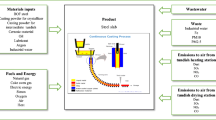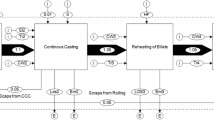Abstract
Continuous casting technology is extensively used in steel production. Refractory materials made from alumina–carbon (Al2O3–C) are integral to the continuous casting process to ensure high-quality steel product. However, the production of Al2O3–C refractory material itself is the source of a range of environmental problems. Life cycle assessment and life cycle cost methods are applied to compare and analyze the environmental impact and economic cost of the Al2O3–C refractory production process in a Chinese factory. The study analyzes the environmental impact and financial cost of Al2O3–C refractory production in the “cradle-to-gate” system boundary. Monte Carlo simulation was used in uncertainty analysis to ensure the credibility of the study. The results indicate that the key environmental impact categories of Al2O3–C refractory production are: freshwater eutrophication, human toxicity, freshwater ecotoxicity, marine ecotoxicity, and natural land transformation. The batching and coal gas preparation processes are the key processes with remarkable environmental impact. They make up 69.5% and 13.5% of the environmental impact load of the Al2O3–C refractory production separately. Sintered corundum and coal are the key materials with significant environmental impact. They constitute 44.4% and 11.3% of the total environmental impact load, respectively. Sensitivity analysis shows that the batching process has a higher optimization priority than the coal gas preparation process. The findings point toward more sustainable methods to manufacture for Al2O3–C refractory materials.
Graphic abstract











Similar content being viewed by others
References
Akhtar S, Reza B, Hewage K, Shahriar A, Zargar A, Sadiq R (2015) Life cycle sustainability assessment (LCSA) for selection of sewer pipe materials. Clean Technol Environ 17(4):973–992
An J, Xue X (2016) Life-cycle carbon footprint analysis of magnesia products. Resour Conserv Recycl 119:4–11
An J, Li Y, Middleton RS (2018) Reducing energy consumption and carbon emissions of magnesia refractory products: a life-cycle perspective. J Clean Prod 182:363–371
Atzenhofer C, Gschiel S, Harmuth H (2017) Phase formation in Al2O3–C refractories with Al addition. J Eur Ceram Soc 37:1805–1810
Bag M, Adak S, Sarkar R (2012) Nano carbon containing MgO-C refractory: effect of graphite content. Ceram Int 38:4909–4914
Chen X, Wu Y, Liang Y, Wang N (2004) Microstructure analysis of used aluminum-magnesium carbon brick. Refractory 38(3):183–185
Chen S, Zhang G, Tian L, Li G (2014) Reuse of used refractory. National refractory raw material development strategy seminar under new situation, pp. 339–341 (in Chinese)
Conejo AN, Lule RG, Lopez F, Rodriguez R (2006) Recycling MgO–C refractory in electric arc furnaces. Resour Conserv Recycl 49:14–31
De Benedetto L, Klemes J (2009) The environmental performance strategy map: an integrated LCA approach to support the strategic decision-making process. J Clean Prod 17(10):900–906
Dias LC, Passeira C, Malça J, Freire F (2016) Integrating life-cycle assessment and multi-criteria decision analysis to compare alternative biodiesel chains. Ann Oper Res. https://doi.org/10.1007/s10479-016-2329-7
Diniz GS, Tourinho TCO, Silva AF, Chaloub RM (2017) Environmental impact of microalgal biomass production using wastewater resources. Clean Technol Environ 19(10):2521–2529
Esmat MA, Darwish H (2008) Vitrification and devitrification phenomena in the ternary MgO–Al2O3–B2O3 system. Ceram Int 34:1965–1969
Ferreira G, López-Sabirón AM, Aranda J, Mainar-Toledo MD, Aranda-Usón A (2015) Environmental analysis for identifying challenges to recover used reinforced refractories in industrial furnaces. J Clean Prod 88:242–253
Fruhstorfer J, Schöttler L, Dudczig S, Schmidt G, Gehre P, Aneziris CG (2016) Erosion and corrosion of alumina refractory by ingot casting steels. J Eur Ceram Soc 36(5):1299–1306
Fuentes A, Garcia C, Hennecke A, Masera O (2018) Life cycle assessment of Jatropha curcas biodiesel production: a case study in Mexico. Clean Technol Envir 20(7):1721–1733
Garcia-Herrero I, Laso J, Margallo M, Bala A, Gazulla C, Fullana-i-Palmer P, Vázquez-Rowe I, Irabien A, Aldaco R (2017) Incorporating linear programing and life cycle thinking into environmental sustainability decision-making: a case study on anchovy canning industry. Clean Technol Environ 19(7):1897–1912
Gui Z, Zhang W, Wang T (2016) Research on energy saving and emission reduction of ladle refractory materials based on LCA. Baosteel Technol 5:35–39
Hanagiri S, Matsui T, Shimpo A, Aso S, Inuzuka T, Matsuda T, Sakak S, Nakagawa H (2008) Recent improvement of recycling technology for refractories. Nippon Steel Tech Rep 98:93–98
Hofstetter P (1998) Perspectives in life cycle impact assessment—a structured approach to combine models of the technosphere, ecosphere and valuesphere. Int J Life Cycle Ass 5(1):58
Hong J, Zhou J, Hong J (2015) Environmental and economic impact of furfuralcohol production using corncob as a raw material. Int J Life Cycle Assess 20(5):1–9
ISO (2006a) International standard. Environmental management-life cycle assessment-principles and framework. https://www.iso.org/standard/37456.html. Accessed 12 Nov 2018
ISO (2006b) Environmental management Life cycle assessment requirements and guidelines. https://www.iso.org/standard/38498.html. Accessed 12 Nov 2018
Leong YK, Show PL, Lan JCW, Loh HS, Lam HL, Ling TC (2017) Economic and environmental analysis of PHAs production process. Clean Technol Environ 19(7):1941–1953
Liao J (2003) The used sliding gate recirculation is used to produce Al2O3–SiC bricks. Refract. Lime 28(6):15–18
Liao N, Li Y, Jin S, Sang S, Harmuth H (2016) Enhanced mechanical performance of Al2O3–C refractories with nano carbon black and in situ formed multi-walled carbon nanotubes (MWCNTs). J Eur Ceram Soc 36:867–874
Liao N, Li Y, Jin S, Sang S, Liu G (2017) Reduced brittleness of multi-walled carbon nanotubes (MWCNTs) containing Al2O3–C refractories with boron carbide. Mater Sci Eng A Struct 689:80–87
Lolli F, Ishizaka A, Gamberini R, Rimini B, Ferrari AM, Marinelli S, Savazza R (2016) Waste treatment: an environmental, economic and social analysis with a new group fuzzy PROMETHEE approach. Clean Technol Environ 18(5):1317–1332
Lu HR, El Hanandeh A (2017) Environmental and economic assessment of utility poles using life cycle approach. Clean Technol Environ 19(4):1047–1066
Lyu L (2012) Effect of MgB2 addition on oxidation resistance of Al2O3–C refractories. Xi’an University of Architecture and Technology (in Chinese)
MIIT (Ministry of Industry and Information Technology) (2016) Steel industry adjustment and upgrading plan (2016–2020) interpretation material. http://www.miit.gov.cn/n1146295/n1652858/n1653018/c5355576/content.html. Accessed 15 Dec 2018
NBSPRC (National Bureau of statistics of the People’s Republic of China) (2017) The national economy achieved a good start in “The 13th Five-Year Plan” in 2016. http://www.stats.gov.cn/tjsj/zxfb/201701/t201701201455942.html. Accessed 15 Nov 2018
NDRC (National Development and Reform Commission) (2016) Industrial green development plan (2016–2020). http://www.ndrc.gov.cn/fzgggz/fzgh/ghwb/gjjgh/201706/t20170621_851925.html. Accessed 10 June 2018
Qi C, Chen Y, Ma X, Yang D, Hong J (2017) Life cycle assessment of the hydrometallurgical zinc production chain in China. J Clean Prod 156:451–458
Roungos V, Aneziris CG (2012) Improved thermal shock performance of Al2O3–C refractories due to nanoscaled additives. Ceram Int 38:919–927
Santagata R, Ripa M, Ulgiati S (2017) An environmental assessment of electricity production from slaughterhouse residues. Linking urban, industrial and waste management systems. Appl Energy 186(2):175–188
Sun F (2009) Research and application of recycled aluminum magnesia carbon brick and magnesium carbon brick. Wuhan University of Science and Technology (in Chinese)
Tan J (2016) Research on automation control of slab continuous casting technology. China CIO News 8:139
Tang HY, Wu GH, Wang Y, Li JS, Lan P, Zhang JQ (2017) Comparative evaluation investigation of slag corrosion on Al2O3 and MgO–Al2O3 refractories via experiments and thermodynamic simulations. Ceram Int 43(18):16502–16511
Wang S (2018) Application of regeneration technology for sliding gate skates in ladle. Refract Lime 43(1):24–28
Wang QH, Li YW, Luo M, Sang SB, Zhu TB, Zhao L (2014a) Strengthening mechanism of graphene oxide nanosheets for Al2O3–C refractories. Ceram Int 40:163–172
Wang H, Li Y, Zhu T, Sang S, Wang Q (2014b) Microstructures and mechanical properties of Al2O3–C refractories with addition of microcrystalline graphite. Ceram Int 40(7):11139–11148
World Metals (2017) Global crude steel output returns to growth in 2016. http://www.worldmetals.com.cn/viscms/xingyeyaowen3686/240285.jhtml. Accessed 09 Nov 2018
Xu B, Zhu HX, Peng N, Deng CJ, Yuan WJ (2014) Study on the oxidation kinetics of in situ β-sialon bonded Al2O3–C refractories. Adv Mater Res 881:1021–1025
Zare R, Nouri J, Abdoli MA, Atabi F, Alavi M (2016) The integrated fuzzy AHP and goal programing model based on LCA results for industrial waste management by using the nearest weighted approximation of FN: aluminum industry in Arak, Iran. Adv Mater Sci Eng 3:1–13
Zhu B, Zhu Y, Li X, Zhao F (2013) Effect of ceramic bonding phases on the thermo-mechanical properties of Al2O3–C refractories. Ceram Int 39:6069–6076
Acknowledgements
This research is supported by Shandong Provincial Key R&D Plan (2018GSF121005), Shandong Natural Science Foundation (ZR2019MEE104, ZR2019MG009), and The Fundamental Research Fund of Shandong University (2018JC049, 2018GN046).
Author information
Authors and Affiliations
Corresponding authors
Additional information
Publisher's Note
Springer Nature remains neutral with regard to jurisdictional claims in published maps and institutional affiliations.
Electronic supplementary material
Below is the link to the electronic supplementary material.
Rights and permissions
About this article
Cite this article
Tang, Y., Shi, Y., Li, Y. et al. Environmental and economic impact assessment of the alumina–carbon refractory production in China. Clean Techn Environ Policy 21, 1723–1737 (2019). https://doi.org/10.1007/s10098-019-01741-w
Received:
Accepted:
Published:
Issue Date:
DOI: https://doi.org/10.1007/s10098-019-01741-w




